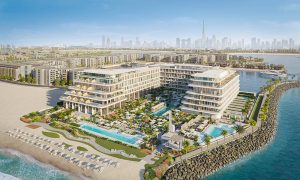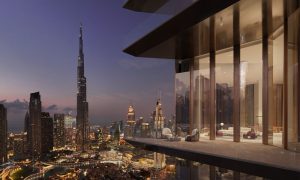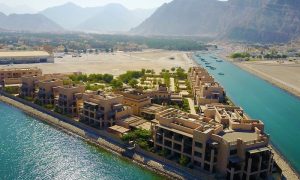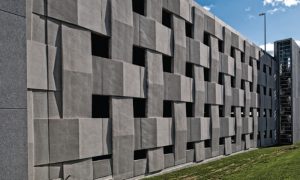MEA Hotels in the Pipeline
There are 455 hotels in the Middle East and Africa development pipeline comprising 126,310 rooms. As the UAE accounts for 50% of these, The Big Project explores the potential of the emirates to attract enough investors and guests to balance supply and demand
It may come as a surprise that many of the UAE’s hotel projects continue to forge ahead in spite of widespread development delays and cancellations more often making the headlines.
Out of 455 hotels in the Middle East and Africa active development pipeline, the UAE accounts for almost 50%. That’s 54,814 rooms out of the 126,310 being developed in the region. Dubai is the largest market, with 32,224 upcoming rooms and the highest number active in the construction phase (16,768).
Since the hotel construction boom of 2006, Dubai has made the headlines for the launch of many iconic high-end hotels, but when the global economic downturn struck in late 2008, the emirate took a major blow as occupancy plunged and rates were slashed by up to 50%. Many investors and developers turned their attention to Abu Dhabi, which had always appeared to take a more sustainable approach to hotel development, having announced longterm development plans surrounding tourism and infrastructure.
In fact, reluctant to keep all of their eggs in one basket, many Dubai developers have expanded into new or emerging markets with the launch of hotel projects.
“Dubai could have once been considered as the market leader in hotel design and construction, but now we are involved in and seeing very interesting projects emerging in Abu Dhabi, Doha, Beirut and other places,” says PLP Architecture partner partner Lee Polisano.
But that is not to say there will not be a demand for the thousands of hotel rooms upcoming in Dubai.
“For leisure tourists, Dubai will always be the destination. Business travellers will continue to be attracted to Abu Dhabi. However, licences for city hotels in the centre of Abu Dhabi are not being issued. There is no space.
So the hotel development focus in the capital is moving to the beachlined outskirts, which poses increased competition to Dubai’s leisure market,” asserts Dubai-based City Seasons Group managing director Thomas Tapken.
Hotel developer and operator, Layia Hospitality set up in Dubai three years ago and opened its first hotel in the emirate at the start of the financial crisis, but today, its Dubai hotels continue to achieve an occupancy level of 80%, according to CEO Daniel Hajjar.
“Obviously the room rates have been affected, but previously the rates were over the top; so it’s been an acceptable adjustment. I don’t think we’ll have challenges with rates any more, the situation has stabilised,” he says.
In fact, Hajjar suggests that the lower rates have encouraged guests — business customers especially — to return to the UAE two or three times. Consequently, the drop in rates has been somewhat offset by the number of return guests in search of a bargain, he says.
But if the success of the Dubai tourism market is dependent on an influx of budget travellers, what does the future hold for the emirate’s numerous luxury five-star properties?
Luxury vs. Budget
PLP Architecture designed the fivestar Four Seasons Hotel at Abu Dhabi Sowwah Island, which is currently being developed. Polisano says: “There is a continued desire for luxury and increased levels of services. We also see an increase in combining residential accommodation with hotel accommodation; offering residents a special level of hospitality service that is usually only available to hotel guests.”
“There will always be a market for five-star luxury,” adds Hajjar, adding that, however, there is a trend towards the budget hotels, which are becoming “acceptable” in this part of the world and therefore challenging the profitability of the highend market.
“Previously, three star properties had a bad reputation for service and products, but the introduction of ‘branded’ budget hotels, such as the Premier Inn and the Holiday Express, has changed this.
“The introduction of low-cost airlines, including FlyDubai, has also helped this market to mature. And of course, people are counting their money — so budget holidays are increasingly attractive,” he adds.
Tapken adds: “Dubai will be a budget destination for the coming year, on the other hand, the only properties on the beach are rated five-star and the only hotels doing well are the five-star hotels.
However, the company is currently developing its first budget, three-star property, the City Seasons Park Hotel, in Abu Dhabi.
Standing Out
Whatever the scale of the hotel, it is important to have a tangible niche.
Hajjar has been in the hotel development industry in the Middle East for around 23 years; witnessing firsthand the good and the bad days. He has seen a switch in the popularity of hotel developments among investors towards a trend for residential buildings due to a perceived higher and more immediate return on investment. However, he says that investors are once again leaning towards hotel projects as a secure longterm investment. “People are realizing you need to have hotels to develop countries.
Oversupply is not good, but when you see the number of planes Emirates Airline is buying, and the investments in airports in Dubai, it tells you that it is safe to invest in Dubai properties.” But you have to have the right product, he warns, not every development will be a sell out — you need to go back to reality.
But what is the right product for the seemingly saturated Dubai hotel market? Hajjar says investors and developers should stay away from five-star hotels — “there are already too many of these in Dubai”.
Layia Hospitality is focused on developing business hotels of either a “very-good three-star standard” or an “excellent four-star” classification, according to Hajjar. Tapken adds that the citybased business hotel sector is a high performer at present.
The 232-key Layia Plaza hotel in Dubai is expected to open in September or October, having experienced a six-month delay due to “planning changes”. Hajjar says that the 140-room Layia Orchid Hotel, also in Dubai, will be handed over in the next six to eight months, while piling and excavation works have started on the 240-room, Dubai-based Layia Dahlia Hotel and the Layia International Financial Hotel in Sharjah, which are expected to open in 2012 and 2013 respectively.
But, the hotel developments are not a priority for the owners, says Hajjar, as hotels are not their core business. When eventually complete, the four additional hotels will bring Layia’s number of hotels in operation to nine, comprising 1439 rooms – mainly in Dubai.
“The owners’ priorities are somewhere else, which means we’re in limbo with dates, but that’s understandable taking into account the financial crisis,” he explains.
On the upside, he says that the cost of building these hotels has got cheaper. When the company first entered the market it could not find anyone to build its hotels – everyone was too busy, but now contractors are calling developers, offering their services at lower prices.
“If the banks were available today, we would see many more projects coming up as the prices are good, but the banks are not lending,” says Hajjar.
On the other hand, Tapken says he has found the building costs to be only “slightly cheaper”, and says that the main challenge in the UAE is bringing in the materials and labour forces from abroad.
Market Opportunities
In addition to its Dubai projects, Layia Hospitality has diversified into other Middle East and Africa markets, having signed a 240- key, four-star deluxe property in Jordan last year.
Hajjar also reveals that Layia Hospitality is in final negotiations for a number of properties in Saudi Arabia, which it hopes to finalise and announce within the next two months.
Similarly, City Seasons Group is expected to handover its new Muscat hotel on December 1.
“It’s very easy to work in Oman, the people are friendly and charming and you don’t encounter the Dubai stress. But it can be difficult to get things done. The project has been ongoing for three and a half years and we have seen delays, which I’d attribute to the laid-back attitude in the country.”
Tapken says that one of the biggest challenges has been communicating with the Oman Municipality to have the utilities connected and switched on.
But this hasn’t put the developer off Oman: “We’re looking at a second project as part of a development featuring three other hotels in Muscat. Two major chains are on board for two of the hotels, which will serve alcohol. We are a dry hotel and Oman is very strict so we believe a City Seasons hotel will work well within this development.”
“We’re also seriously looking into Saudi Arabia and Qatar. There are only four or five cities interesting for any developer in Saudi Arabia. The population is tremendously growing in line with infrastructure. The people coming in to develop these projects need somewhere to stay. We offer city hotels; that is our niche and Saudi Arabia is exactly where we should be,” says Tapken.
“City Seasons is going the right way, nothing new is being announced in the UAE presently and all ongoing projects are being completed within the next two or three years. I don’t think the business we had previously will ever return to how it was. But in Dubai, the city is continuing to build the infrastructure which makes it attractive to open a business here. Projects are still being driven by the government so it’s good to know there is a future.
“We will remain where we are in the UAE. Within the next five years we want to have 15 properties across the region,” reveals Tapken.
In Conclusion
The global economic downturn has driven developers to identify opportunities in new markets and develop clear niches in terms of region, hotel classification and design, but industry players remain positive about Dubai’s future potential to attract leisure and business tourists, as well as Abu Dhabi’s growing sector.
Furthermore, PLP Architecture outlines a wider consequence of changes in the economic environment, saying that hotel projects’ massing, facade design, structural systems and services strategy have all been affected. “We are seeing a balance being struck between the parametres of ‘bigger and better’, which were often a criteria for hotel design in this region in the past. Bigger is not always better.
The desire to create a memorable guest experience is one of the key drivers of making a hotel better. Better is about competition and will remain a key driver of design as will the quality of the guest experience,” says Polisano.





















